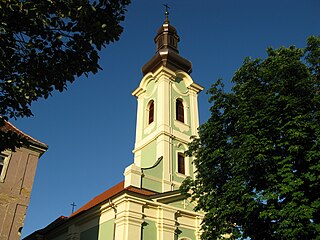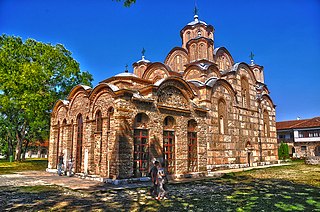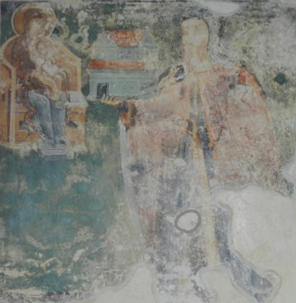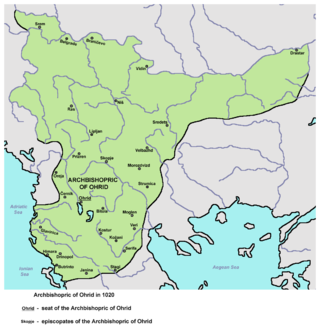Related Research Articles
The Serbian Orthodox Church is one of the autocephalous Eastern Orthodox Christian churches.

The Eparchy of Gornji Karlovac is an eparchy of the Serbian Orthodox Church seated in the city of Karlovac, Croatia. It covers the area of Banovina, Kordun, Lika, Krbava, Gorski Kotar, as well as northern Croatia and Istria.

The Gračanica Monastery is a Serbian Orthodox monastery located in Kosovo. It was built by the Serbian king Stefan Milutin in 1321 on the ruins of a 6th-century basilica. The monastery was declared a Monument of Culture of Exceptional Importance in 1990, and on 13 July 2006 it was placed on UNESCO's World Heritage List under the name of Medieval Monuments in Kosovo as an extension of the Visoki Dečani site which was overall placed on the List of World Heritage in Danger.

Makarije Sokolović was the Archbishop of Peć and Serbian Patriarch from 1557 to 1571. He was the first head of the restored Serbian Patriarchate of Peć, after its lapse in 1463 that resulted from the Ottoman conquest of Serbia. He is variously reported to have been the brother, nephew, or first cousin of the Ottoman Grand Vizier Mehmed-paša Sokolović, who used his influence in the Ottoman Empire to reestablish the Serbian Patriarchate with its seat in Monastery of Peć. Patriarch Makarije is celebrated as a saint in the Serbian Orthodox Church.

Stefan Stefanović, known as Tenka (Тенка), was a Serbian politician who served as the Prime Minister of Serbia. Stefanović was a leader of pro-Obrenović group that conspired against Prince Alexander Karađorđević. As a result, in 1840, Tenka Stefanović was forced to join a group of Constitutionalists who were sent in exile to Constantinople.

Savatije Sokolović, was Archbishop of Peć and Serbian Patriarch from 1585 to 1586. Before that, he served as Metropolitan of Herzegovina from 1573 to 1585. He was a member of the notable Sokolović family, being a nephew of Serbian Patriarch Makarije Sokolović (1557–71). Savatije founded the Piva Monastery in 1573.

The Metropolitanate of Dabar-Bosnia is a metropolis of the Serbian Orthodox Church in Bosnia and Herzegovina, seated in Sarajevo. Since 2017, Metropolitan of Dabar and Bosnia is Hrizostom Jević.

Eparchy of Lipljan, later known as the Eparchy of Gračanica or the Eparchy of Novo Brdo is one of the former historical Eastern Orthodox eparchies of Serbian Orthodox located in the central parts of Kosovo region.. It is now part of Eparchy of Raška and Prizren. In older research, it was mistakenly identified as the bishopric of Ulpiana.
Mojsije I Rajović was the Archbishop of Peć and Serbian Patriarch, head of the Serbian Orthodox Church, from 1712 to 1725, with seat in the Patriarchal Monastery of Peć.

Antonije I Sokolović was the Archbishop of Peć and Serbian Patriarch from 1571 to 1574. He was the second primate of the restored Serbian Patriarchate of Peć, and nephew of previous Serbian Patriarch Makarije I.
Gerasim I Sokolović was Archbishop of Peć and Serbian Patriarch from 1574 to 1586. He was the third primate of the restored Serbian Patriarchate of Peć, and cousin of previous Serbian Patriarch Antonije I.

Stojan Simić was a Serbian politician and businessman. He was known as a talented speaker and constitutional defender.

Miron Nikolić was bishop of the Serbian Orthodox Church.
Mileta Radojković, Prince of Jagodina, Grand Count of Rasina was a participant in the First Serbian Uprising and Second Serbian Uprising, and was the first and most important prince of the Jagodina Nahija and held the title of Serdar Rasinski. He was also an honorary member of the Society Of Serbian Letters.
Jerotej Sokolović also Jeortej, Serbian Patriarch was the archbishop of the Serbian Patriarchate of Peć and the Serbian patriarch from 1589 to 1591. He succeeded Patriarch Nikanor I on the throne of the Serbian Patriarchate. He spent a very short time as a Serbian patriarch. He was succeeded by Patriarch Filip I.
Filip I was the Serbian patriarch from 1591 to 1592. He succeeded Patriarch Jerotej Sokolović on the throne of the Peć Patriarchate on 15 July 1591. At the time when he was the patriarch, the situation for the Serbian Orthodox Church was very critical. Filip died in 1592 and Patriarch Jovan Kantul became his heir.
Archimandrite Arsenija Gagović is remembered as the renovator of Piva monastery and one of the major players in the liberation of Serbia from the Ottoman Empire before and during the First and Second Serbian Uprising. Folk songs and tradition speak of him among the faithful and the clergy as Arsenije Pivski who travelled to the Holy Land.
Lav Anikita Filolog was a late 15th and early 16th-century Serbian writer who worked mostly in Russia.
References
- ↑ Burgess, Michael (1995). Lords Temporal and Lords Spiritual: A Chronological Checklist of the Popes, Patriarchs, Katholikoi, and Independent Archbishops and Metropolitans of the Autocephalcus Monarchical Churches of the Christian East and West. ISBN 9780893703264.
- ↑ "Google Scholar". scholar.google.com.
- 1 2 Šakota, Mirjana (August 20, 1966). "Monastery Treasuries in Serbia". Turistička štampa – via Google Books.
- ↑ Bataković, Dušan T. (2014). The Foreign Policy of Serbia (1844-1867): IIija Garašanin's Načertanije: La politique étrangère de la Serbie (1844-1867): Načertanije d'Ilija Garašanin. Balkanološki institut SANU. ISBN 978-86-7179-089-5.